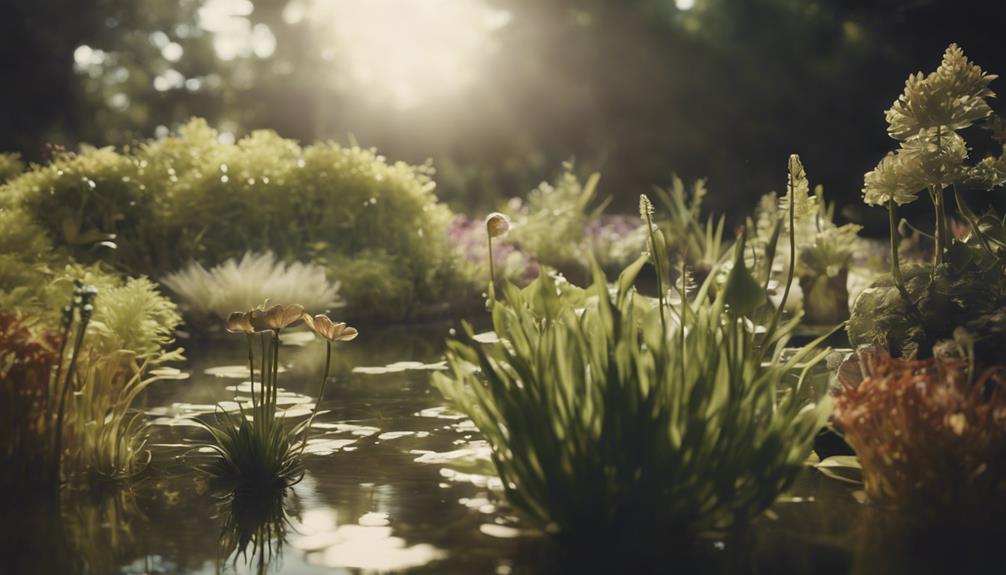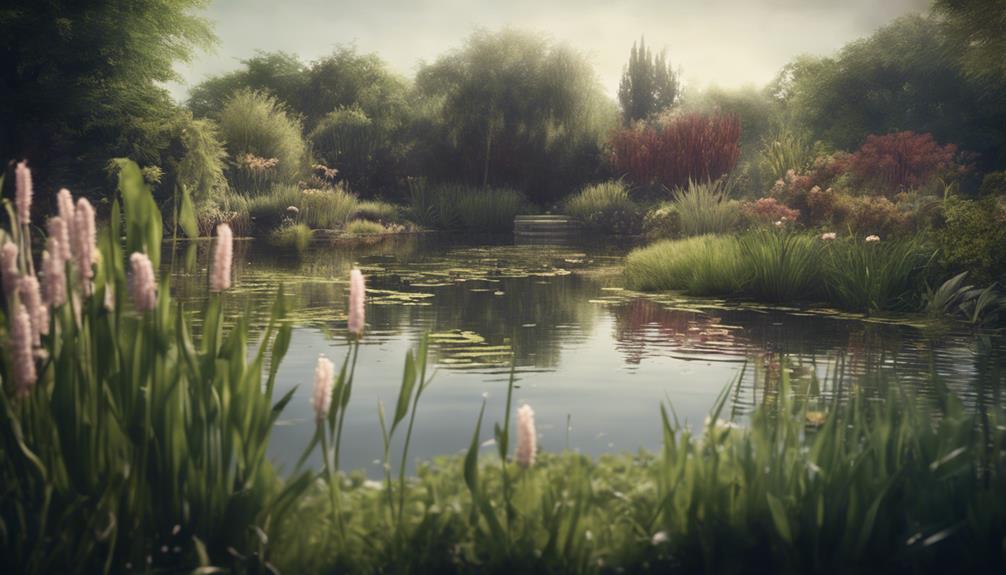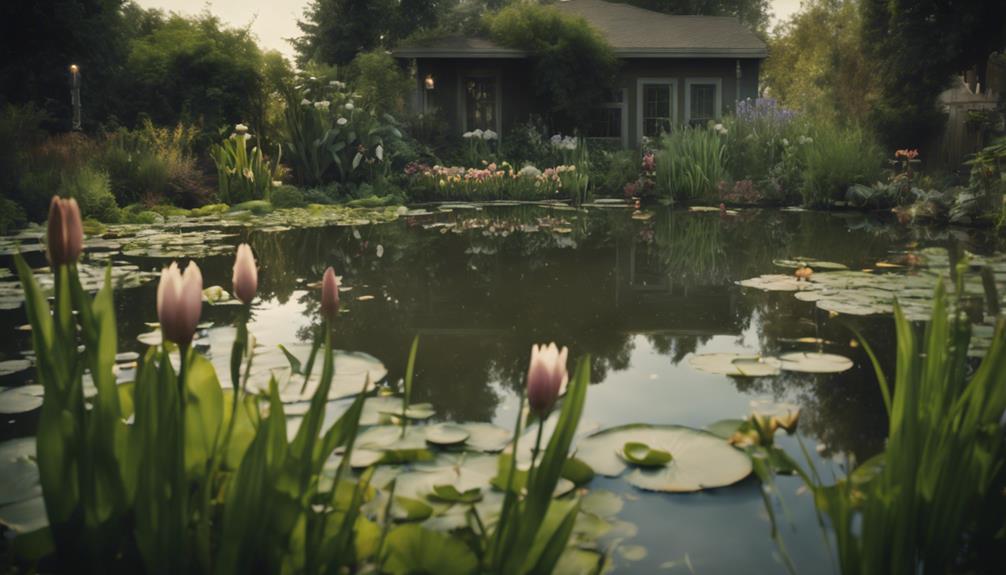When creating a thriving aquatic ecosystem in your large yard, you'll need to select plants that not only complement your outdoor space but also meet the unique needs of your water feature, considering factors such as sunlight levels, water depth, and growth habits. Choose lotus and water lilies for deeper areas, or opt for canna lilies and swamp lilies for shallower zones. Be mindful of sunlight requirements, as full sun plants like lotus and cattail need at least six hours of direct sunlight. Consider native plants to maintain ecosystem balance, and think about growth habits to promote a harmonious water garden.
Table of Contents
Key Takeaways
- Consider plants with varying growth habits and sizes to create visual interest and balance in a large yard water feature.
- Choose plants that thrive in different sunlight levels, from full sun to partial shade, to ensure a diverse and healthy ecosystem.
- Select native plants that provide a habitat for local wildlife and maintain ecosystem balance, avoiding invasive species that can cause harm.
- Incorporate plants with different water depth requirements, from shallow to deep, to create a dynamic and thriving aquatic environment.
- Consider plants with varying peak growing seasons to maintain water quality and ensure a balanced ecosystem throughout the year.
Understanding Aquatic Plant Needs
When designing an aquatic plant arrangement for your large yard, you must carefully consider the unique needs and personalities of each cultivar, as they require specific conditions to thrive and contribute to a balanced ecosystem.
Aquatic plants have different requirements, and understanding these needs is essential for creating a harmonious water garden. For instance, some plants demand full sun, while others prefer partial shade. Wet soil and shallow water are ideal for certain species, whereas others thrive in deeper water.
You must also be mindful of water quality, as plants play a key role in maintaining it. By incorporating plants with varying peak growing seasons, you can provide year-round water quality benefits.
Additionally, be aware of regional climate conditions and invasive species that can disrupt the balance of your water garden. By taking these factors into account, you can create a thriving aquatic ecosystem that brings beauty and serenity to your outdoor space.
Choosing Plants for Water Depth
As you plan your aquatic plant arrangement, think about the varying water depths in your large yard and select plants that thrive in specific ranges, from shallow to deep.
For instance, lotus and water lilies excel in water depths of 1-4 feet, with lotus preferring full sun and water lilies tolerating partial shade.
If you have shallower areas, canna lilies and swamp lilies perform well in water depths of just 1-6 inches. Sweet flag and corkscrew rush can also thrive in these shallow zones, with sweet flag preferring partial shade and corkscrew rush tolerating full sun.
For unique additions, purple pitcher plants and carnivorous plants require a water depth of 1-6 inches, with most species preferring full sun.
Deeper areas can feature plants like pickerelweed, broadleaf arrowhead, and hornwort, which can thrive in water depths of 6-12 inches or more.
Selecting Plants for Sunlight Levels

Considering the unique sunlight patterns in your large yard, you'll want to select aquatic plants that match the specific sunlight levels in different areas of your water feature.
Full sun aquatic plants like lotus, water lily, and cattail require at least 6 hours of direct sunlight per day to thrive. These plants will flourish in areas that receive maximum sunlight, producing vibrant flowers and lush foliage.
On the other hand, plants like Japanese iris, pickerelweed, and cardinal flower prefer partial shade to full sun, requiring 4-6 hours of direct sunlight per day. They'll do well in areas that receive moderate sunlight.
If you have shadier areas, plants like sweet flag, corkscrew rush, and hornwort can tolerate partial shade to full shade, requiring less than 4 hours of direct sunlight per day.
Considering Growth Habits and Size
To create a balanced and visually appealing aquatic environment in your large yard, you'll need to take into account the growth habits and mature sizes of the plants you're selecting, as they can profoundly impact the overall aesthetic and functionality of your water feature.
Lotus plants, for instance, can grow up to 6 feet tall, making them a prominent feature in your water garden.
Water lilies, on the other hand, typically spread 3-5 feet in diameter, providing a beautiful, serene atmosphere.
Canna lilies can reach heights of 6-8 feet, spreading 2-3 feet wide, and require regular pruning to maintain their desired shape and size.
Pickerelweed can grow up to 5 feet above the water's surface, with a spread of 1-2 feet, making it a suitable choice for larger water features.
Japanese Iris typically grows 2-3 feet tall, with a spread of 1-2 feet, and requires regular division to maintain its size and promote healthy growth.
Native and Invasive Plant Considerations

You'll want to exercise caution when selecting aquatic plants for your large yard, as the introduction of non-native species can have devastating consequences for the local ecosystem. Native plants, like iris and soft rush, are essential for maintaining ecosystem balance and providing a habitat for local wildlife. In contrast, invasive plants can outcompete native species for resources, alter habitats, and even change ecosystem processes.
| Plant Type | Characteristics |
|---|---|
| Native Plants | Provide food and shelter for local wildlife, help maintain ecosystem balance |
| Invasive Plants | Outcompete native species, alter habitats, change ecosystem processes |
| Native Iris | Thrives in wetlands, provides habitat for local wildlife |
| Invasive Purple Loosestrife | Forms dense stands, displaces native vegetation, reduces biodiversity |
When choosing aquatic plants, it's vital to select species that are native to the local region. This can help prevent the introduction of invasive species, which can cause long-term damage to the environment. By selecting native plants, you'll be contributing to a balanced ecosystem and preserving the natural beauty of your waters edge. Remember, native plants are the key to a thriving and sustainable aquatic environment.
Frequently Asked Questions
What Is the Most Hardy Aquarium Plant?
You're searching for the most hardy aquarium plant? Stop your search! Lotus plants stand out as a tolerant species, offering low maintenance, coral-friendly growth, and serving as nitrate reducers and oxygen producers, making them a top choice for beginners.
What Is the Fastest Growing Invasive Aquatic Plant?
You're charting the murky waters of invasive aquatic plants, and you're wondering which one grows the fastest. Delve into the world of Water Hyacinth, outpacing Water Wisteria, Cabomba, Hydrilla, Eurasian Milfoil, and others, with its biomass doubling in just 5-7 days, leaving a trail of ecological destruction.
What Is the Easiest Aquatic Plant to Grow?
You'll find the easiest aquatic plants to grow are those that thrive in various conditions, like Canna Lily, requiring minimal care and adaptable to shade and soil types, making them perfect for beginners seeking low-maintenance freshwater favorites.
What Are the Most Beautiful Pond Plants?
Your pond's canvas awaits a masterpiece! You'll be mesmerized by Water Lilies' majestic blooms, floating like jewels on the surface, surrounded by colorful floating islands, aquatic vines, and sun-kissed plants like Exotic Species, fragrant flowers, and shallow dwellers like Pickerelweed.
Conclusion
With a plethora of aquatic plants to choose from, your large yard is about to become a thriving oasis!
You've mastered the art of selecting plants that thrive in varying water depths, bask in the perfect amount of sunlight, and showcase stunning growth habits.
By choosing native plants and avoiding invasive species, you're ensuring a harmonious ecosystem.
Now, get ready to immerse yourself in a world of aquatic bliss, where your yard becomes a serene retreat, teeming with life and beauty!

